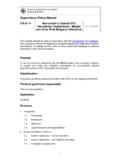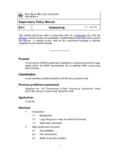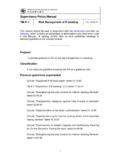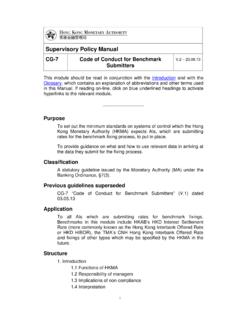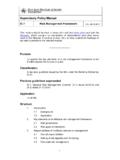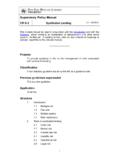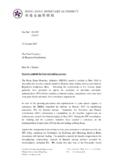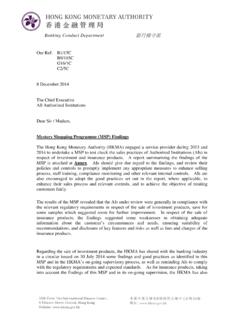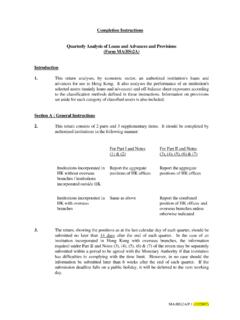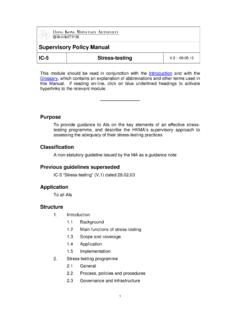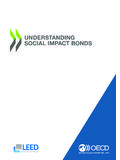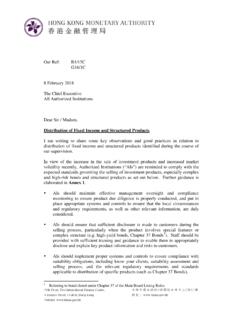Transcription of Annex 1 Key observations and good practices noted …
1 Annex 1 Key observations and good practices noted in respect of distribution of fixed income and structured products 1. Product due diligence ( PDD ) In conducting due diligence of certain bonds, an AI overly relied on the PDD assessment of its Head Office without implementing appropriate measures to ensure that all relevant factors, including local regulatory requirements, were duly taken into account. In certain cases, the assessment of the Head Office was fully adopted without review. For some Chapter 37 Bonds, another AI overly relied on external credit ratings without proper assessment of the complexity and special features of the bonds.
2 Some AIs failed to adequately consider key product features and risks of some complex and/or high-risk bonds, and assigned unduly low risk ratings to such bonds. Examples include bonds that are subordinated, contingent convertible, below investment grade or unrated, or Chapter 37 Bonds that are complex, risky or illiquid. In some cases, the AIs did not take into account some fundamental factors such as the higher risk associated with the business nature of the issuer and the financial position of the issuer or the credit enhancement provider(s). A few private banks originally intended to sell certain products (such as contingent convertible bonds) to customers only on an unsolicited basis, and therefore did not perform PDD on those products.
3 Nevertheless, this intention was not specified in the policies and procedures, and some sales staff made investment recommendation or solicitation to customers in respect of such products. In another case, the AI s practice of distributing bonds with extendable or loss absorption features to Professional Investors only was not set out in its policies and procedures. Relevant functional units, such as Risk and Compliance, were not involved in the PDD process of an AI in respect of individual complex or high-yield bonds. A few AIs did not maintain adequate records to demonstrate the consideration made during the PDD assessment.
4 For example, they did not maintain documentation to reflect the factors that had been considered or the rationale for modifying the target customers of Chapter 37 Bonds. Good practices An AI designed a template which included checkpoints to remind staff to identify whether a bond had any special features ( perpetual, Chapter 37 Bonds) and consider imposition of any relevant selling restrictions to facilitate its PDD process. Annex 1 Regulatory standards AIs should establish and implement appropriate and effective systems and controls to ensure that PDD assessment of the investment products should be fair and balanced, taking into account the local circumstances and regulatory requirements, as well as other relevant information that is reasonably available.
5 While AIs may make reference to risk ratings published by independent research companies or credit ratings assigned by credit rating agencies, such ratings should not be the sole factors to be considered1, and AIs should arrive at their own assessment. Relevant functions, including Risk and Compliance, should be involved in the PDD process. AIs should put in place robust methodologies for assessing product risk and assigning product risk ratings, with particular attention to factors that may warrant assigning a higher product risk rating2. In respect of debt securities, any special features or complex structure and the applicable local regulatory requirements should be taken into account.
6 2. Disclosure of product information During the selling process of some bonds, several AIs failed to highlight and explain the key features and risks of the products to the customers ( whether the bond is unsecured, subordinated, callable; any deferred interest payment; priority of repayment; any non-viability loss-absorption mechanism; creditworthiness of the issuers, guarantors and credit enhancement providers). Similar findings were identified in respect of selling of accumulators by a private bank ( worst case scenarios and margin requirements). Some AIs did not provide any bond offering or product documents to customers during the selling process, or provided such documents only upon customers request.
7 A private bank provided explanatory materials on the features and risks of accumulators to the customers before their first transactions. Nevertheless, it did not require its sales staff to explain the content of the materials to the customers. For some customers who had not invested in a product for several years, the bank did not explain to them the risks and features to ensure the customers well understand the related risks before conducting the transactions. An AI provided to customers with an integrated set of product materials or fact sheets which contained generic description of the features and risks of different types of products only.
8 The sales staff did not highlight the relevant parts or explain those features and risks applicable to the specific type of product to be distributed. 1 Question 4 of the SFC s FAQs on Compliance with Suitability Obligations updated on 23 December 2016 2 HKMA s circular Product Risk Rating of High-yield Bonds and Related Products of 9 August 2013 Annex 1 Good practices An AI provided sales script to guide sales staff to disclose the key risks associated with different types of bonds ( high-yield bonds and contingent convertible bonds, etc.)
9 Regulatory standards Where available, AIs should provide customers with up-to-date prospectuses, offering documents/ circulars and other up-to-date documents relevant to the investment products recommended to the customers3. AIs should also make adequate disclosure of relevant information in its dealing with customers4. Among others, this includes disclosure and explanation of key product features and risks to help customers make informed investment decisions. 3. Suitability assessment and selling practices In respect of bonds which were perpetual or bonds with long tenor, a few AIs did not take into account customers investment horizon when making a recommendation or solicitation of such bonds with low liquidity.
10 A private bank did not require its sales staff to assess the concentration risk of its customers exposure to bond issuers of high credit risk. Another private bank did not have sufficient guidance and controls to ensure that its staff adhere to concentration threshold. As a result, some sales staff solicited customers to enter into new accumulator contracts even though the customers exposure had already exceeded the internal concentration threshold. In some other cases, concentration assessment was only performed after the transactions were executed. For some risk-mismatched Chapter 37 bond transactions conducted over the phone, no adequate documentation had been maintained to support an AI s representation that suitable alternatives had been recommended to the customers.
